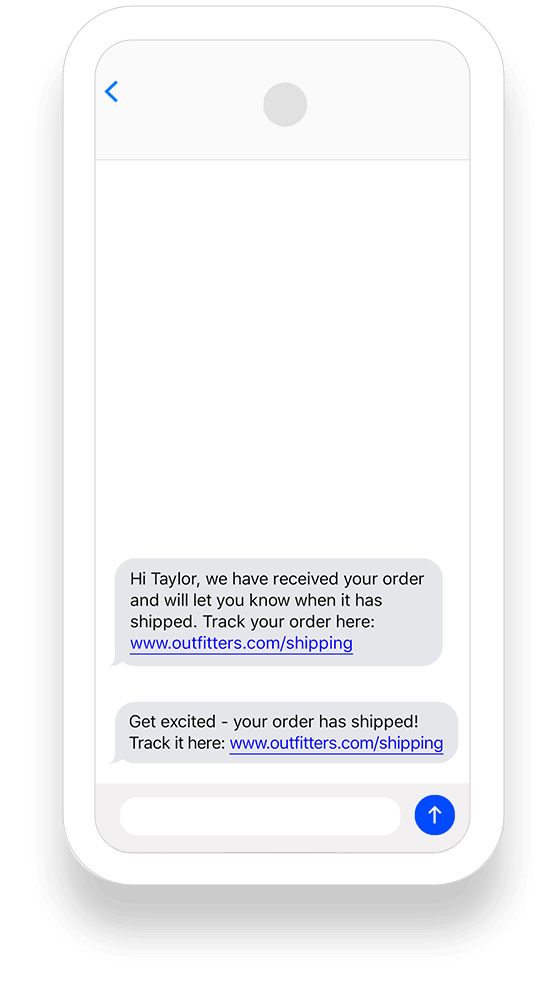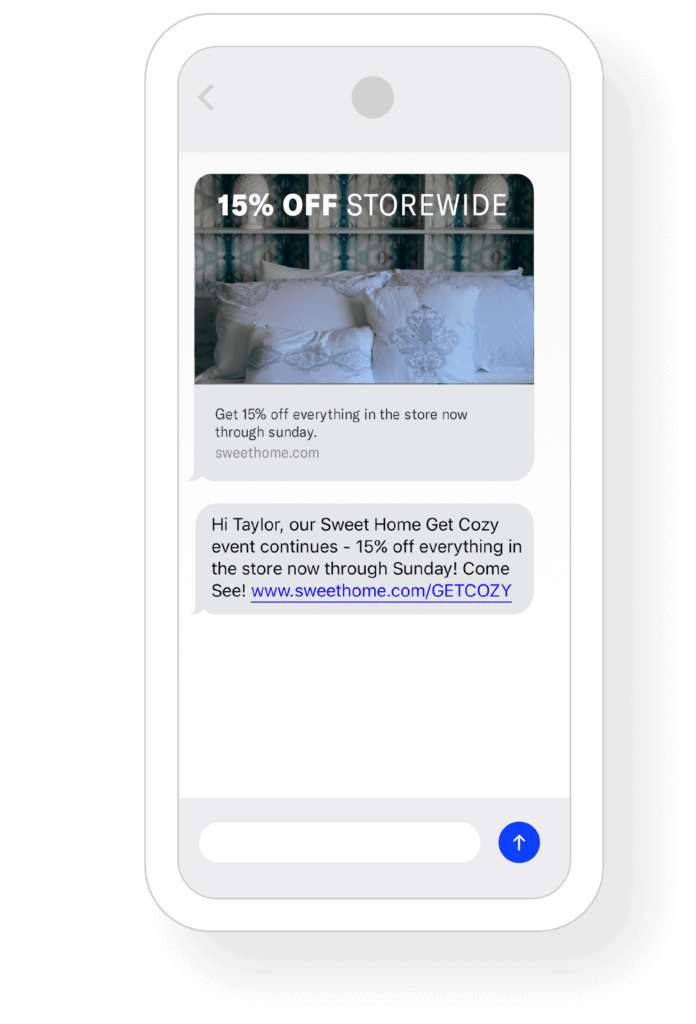
What’s the Difference Between MMS and SMS?

Share to my network
In this article
Categories
Book a meeting
Connect with our team of experts to discuss your conversion and loyalty goals, and how we can help you achieve them faster.
Book a meetingIt’s no exaggeration to say that almost everybody is familiar with text messaging. But do you know the difference between MMS and SMS? Globally, more than 7.49 billion people have mobile devices — and most can send and receive texts, especially in advanced economies like the U.S., where roughly 97% of the population texts at least once daily. Text messaging is a powerful marketing channel with massive reach and high engagement rates.
Yet, despite widespread use, many consumers may not realize that the messages ubiquitously referred to as texts come in two distinct formats: Short Message Service (SMS) and Multimedia Message Service (MMS).
So, what’s the difference between MMS and SMS, and how do marketers and brands use them? Read on to learn more.
What Is SMS?
When you think of a typical text message, it’s probably an SMS. First developed in the 1980s, SMS is a service for sending short, text-based messages of up to 160 characters to mobile devices. SMS messages are typically viewed through a device’s native messaging app. If a text exceeds the character limit, it will appear as successive messages to the user.
SMS is growing rapidly as a marketing channel due to its high engagement rates. The success of SMS marketing comes down to one simple fact: Consumers don’t let their texts go unread. Texts aren’t caught in spam filters, forgotten in an inbox or lost somewhere in the mail. Studies have found that 98% of SMS messages are opened, and 90% are read within just three minutes.

Short Message Service Explained
Short message service (SMS) is the technology of exchanging text messages between mobile devices. Unlike waiting for customers to open an email or mobile app, SMS messages are seen and acted on quickly, helping brands drive conversion rates between 21% and 32%.
One of the benefits of SMS is accessibility. Users only need a cell signal to receive messages from your brand, allowing you to connect with them whether they’re commuting, at the office, working out at the gym or cooking at home.
SMS Character Limitations and Constraints
With an SMS, you can only send a message of 160 characters or 70 special characters. Anything above this limit will be sent through a sequence of messages, which can add up costs and delay your message. Aside from character limitations, SMS has limited security since there is no encryption.
Common SMS Use Cases for Businesses
Aside from promoting your product and services, there are multiple SMS use cases for your business. Here are a few ways to leverage this marketing channel as part of your customer engagement strategy and drive conversions.
Customer Notifications
Customers want to stay in the loop, no matter your industry. Use SMS technology to send:
- Appointment reminders
- Order confirmations
- Delivery updates
- User-request password resets
- Security alerts
- Limited-time or exclusive promotions
Using SMS to send these types of customer notifications builds trust between you and your customers.
Authentication and Security
Have you ever been prompted to send a one-time SMS code to your phone to reset your password? SMS is a fast and easy way for users to verify their identity and access necessary information.
What About MMS?
MMS offers all the benefits of SMS — and then some. Like their SMS counterparts, these multimedia messages are handled by the same native apps used for text messaging. However, as the name implies, the key difference between SMS and MMS is that MMS can include multimedia. That includes pictures, animated GIFs, audio clips and video. MMS messages also don’t have a standard text limit, allowing for longer messages of up to 1,600 characters.
Organizations that use SMS marketing can also send MMS to their audience of opted-in users. Plus, MMS messages include a fallback, ensuring that users who can’t view the original MMS message still receive a message that makes sense.

Multimedia Messaging Service Explained
Multimedia messaging service (MMS) is similar to short message service but offers your brand a visual and engaging way to personalize your message.
MMS messages have a 20% higher click-through rate than SMS. Why? Because MMS lets you send engaging visuals to encourage your users to take action, rather than skimming through a static SMS message.
Types of Media Supported by MMS
MMS supports various media types to customize your messaging and capture your audience’s attention. Here are a few ways to use MMS to enhance your brand messaging and increase conversions.
Image and Photo Capabilities
While an SMS is a great way to promote urgency with limited-time offers, it might not always be the best method for communicating the value and emotion of your brand.
With an MMS, you can send images and photos to emphasize your message and encourage your customers to take action, especially if you’re launching a new product or hosting a brand event.
For example, instead of sending a long, detailed message about the details of your event, create a flyer to quickly relay the critical information attendees need.
Video and Audio Support
Did you know that 73% of consumers use short-form videos to research a brand’s products or services? Drive more traffic to your mobile app or website by sending an MMS with a short video of a customer testimonial, personal introduction or product demonstration. Any way you can visually and creatively communicate your message can make a big impression without overwhelming your audience.
GIFs and Rich Media Content
Everyone loves a funny GIF or a relatable meme — but it may not always make the most sense for your brand voice.
For example, if you position yourself as an authoritative thought leader in your industry, sending a GIF or other rich media content may confuse your target audience. However, if your brand voice is more lighthearted and fun, an MMS with a GIF or meme could be a great way to capture engagement and drive brand loyalty.
MMS Size Limitations and Requirements
Just like SMS, there are sizing limitations and requirements you need to follow before sending out a bulk MMS message. Here are a few things to keep in mind.
Character Count Expansion
Unlike an SMS that only lets you send 160 characters, an MMS allows up to 1,600 in a single message. Even though you have more characters to work with, your message should always be clear and easy to scan.
File Size Restrictions
If you plan to send an MMS with a GIF, image, video or audio clip, it must support a file size of 300 KB to 600 KB. Any media file larger than this will cause delivery issues and may have a low-quality resolution.
SMS vs. MMS: Which Is Better?
Now that you know the difference between SMS and MMS, which one should you choose, and how should you use them effectively? The answer depends on your goals. Let’s discuss how to make the most of both the MMS and SMS differences, depending on your customer engagement strategy.
How to Use SMS vs. MMS Effectively for Your Business
SMS and MMS are two powerful methods to communicate the value of your brand to your target audience. Still, the key is to choose the correct format for your marketing and customer engagement strategy. Here’s how to use SMS vs. MMS effectively for your business and drive results.
Marketing Campaign Strategies
If your goal is to create urgency and drive conversions, use SMS for:
- Event reminders
- Product launch dates
- Limited-time offers & promo codes
If your goal is to tell your brand story and creatively create excitement, use MMS for:
- Teasing a new product with a photo or video
- Sharing a customer testimonial
- A new collection or event announcement
Customer Engagement Tactics
Your customers aren’t just looking for a sales pitch; they want a relationship with your brand. Use an SMS or MMS to send:
- A personalized birthday message and exclusive offer
- A welcome message after they’ve completed their first purchase
- A quiz or survey form to gather zero-party insights and create customized campaigns
- A sneak peek of a new collection
- An anniversary message to celebrate their loyalty
ROI and Performance Considerations
There are several factors to consider when tracking and reviewing the ROI and performance of your SMS vs. MMS efforts, including messaging frequency, conversion rates, costs and industry-specific recommendations.
Cost-Benefit Analysis
While SMS vs. MMS are an effective way to reach your customers directly on their mobile devices, the two differ in terms of cost:
- SMS costs less per message and can be sent out as part of a bulk SMS marketing campaign.
- MMS costs more per message but is more visually appealing and can capture more clicks and conversions.
If you aim to create brand awareness and conversions with visual storytelling, MMS could be worth the higher costs. Still, SMS is a more cost-effective alternative if you’re looking to send a customer notification or promotion quickly.
Industry-Specific Recommendations
Not every industry uses SMS or MMS in the same way. Here are a few recommendations on leveraging the difference between SMS and MMS to tailor your marketing campaign to your industry.
Retail & eCommerce
SMS: Send sales and customer notifications.
MMS: Create an image or video to showcase new arrivals or product tips.
H5: Healthcare
SMS: Send appointment reminders and follow-ups.
MMS: Send an infographic or short video explaining a wellness program or pre- or post-op instructions for an upcoming procedure.
H5: Travel & Hospitality
SMS: Send appointment reminders and follow-ups.
MMS: Send an infographic or short video explaining a new service, health procedure or wellness program
Sports & Entertainment
SMS: Inform fans of live scores, ticket sales and event venue updates.
MMS: Share highlight reels, event countdowns and user-created content.
Frequently Asked Questions About SMS vs. MMS
Have more questions about the difference between SMS and MMS? Read through our FAQ section below to learn if SMS or MMS is the best channel for your next marketing campaign.
Should I Have MMS or SMS Enabled?
Yes, you should enable MMS and SMS to send personalized content and promotions to your customers. To enable MMS and SMS as a marketer, you’ll need to use a customer experience platform, not just a phone, to store your contacts in one centralized location.
What Is the Difference Between SMS and MMS on Android?
The difference between SMS and MMS on Android comes from the content and the WiFi connection. If you send a message within 160 characters, this is an SMS. If you send a message with a 1,600-character limit, this is an MMS. You can only send and receive an MMS on Android if you’re properly connected to WiFi.
How Do I Know If I’m Using SMS or MMS?
It’s straightforward to tell if you’re using SMS or MMS messages with your customers. If your message is just plain text written in 160 characters, you’re using SMS. If your message features a photo, GIF or video, you’re using MMS.
Why Is My Phone Using MMS Instead of SMS?
As a marketer, you always want to test how your message appears on your phone before sending a bulk SMS campaign to your customers. If you discover your phone is using MMS instead of SMS, here’s what might be happening:
- The message exceeds the SMS limit of 160 characters.
- The message was sent to a large group of recipients.
- Your carrier’s settings might automatically default to MMS.
To resolve this, you need to review the length of your messages, contact your carrier or try a different communication method.
Orchestrate Seamless SMS Campaigns With Airship’s CXP
Airship’s customer engagement platform provides everything you need to connect with your audience and leverage the strengths of MMS vs. SMS. Orchestrate your text campaigns as part of a multi-channel engagement strategy, segment your audiences, manage opt-ins/outs, schedule personalized messages, monitor performance and more — all in one convenient package.
An excellent text message marketing strategy opens up a world of possibilities for creating better, deeper and more valuable connections with your customers. For more insights and ideas, check out our SMS marketing explainer. And if you’d like to learn more, get in touch to discuss how Airship can help!


